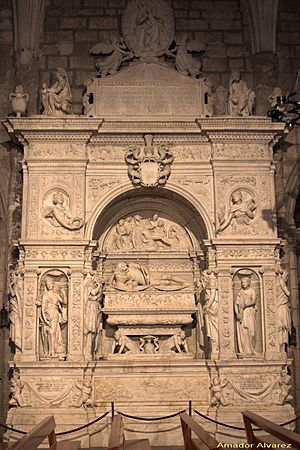Giovanni da Nola facts for kids
Giovanni da Nola (born 1478, died 1559) was a famous Italian artist during the Renaissance period. He was known as both a sculptor (someone who creates statues) and an architect (someone who designs buildings). Giovanni da Nola was also called Giovanni Merliano. He spent most of his working life in the city of Naples, Italy.
Contents
Early Life and Training
Giovanni da Nola was born in a town called Nola, which is close to Naples. His father was a merchant who sold leather.
When he was young, Giovanni moved to Naples. There, he learned his artistic skills from two well-known artists, Aniello del Fiore and Benedetto da Maiano. Later, he traveled to Rome, where he was inspired by the great artist Michelangelo. After his travels, he returned to Naples and worked there for the rest of his life.
Buildings He Designed
Giovanni da Nola designed many important buildings in Naples. One of his most famous architectural works is the Palazzo Giusso. Today, this palace is part of the Naples Eastern University.
His Sculptures and Artworks
Giovanni da Nola created many beautiful statues. Some of his sculptures were moved from Naples to Spain. This happened because the "viceroys" (who were like governors) of Naples were in charge of the area for the Spanish king.
One of his most important sculptures is the tomb of Ramón de Cardona. Ramón de Cardona was a viceroy who died in Naples in 1522. Giovanni da Nola built his tomb in Naples. Later, the tomb was carefully taken apart and moved to Bellpuig in Spain, where Ramón de Cardona was buried. This tomb is still a great example of Italian Renaissance art in that region of Spain.
Many of Giovanni da Nola's artworks can still be seen in the churches of Naples. These include:
- The tomb of Francesco Carafa in the church of San Domenico Maggiore.
- An altar (a special table used in church services) in San Lorenzo Maggiore.
- Statues of saints in San Giovanni a Carbonara.
- Tombs for three young people from the Severino family in the church of Santi Severino e Sossio.
- An altar in Sant'Anna dei Lombardi.
Giovanni da Nola also helped decorate the city for a special event. In 1535, Emperor Charles V visited Naples. Da Nola created decorations for his arrival, and some of these can still be seen on the Porta Capuana, an old city gate.
His Students
Giovanni da Nola taught many artists. Some of his students included Nicola of Naples, Ferdinando Manlio, and Cola dell'Amatrice.
See also
 In Spanish: Giovanni da Nola para niños
In Spanish: Giovanni da Nola para niños


